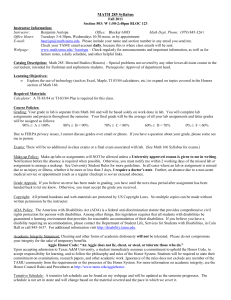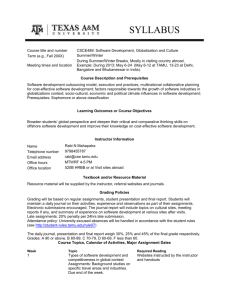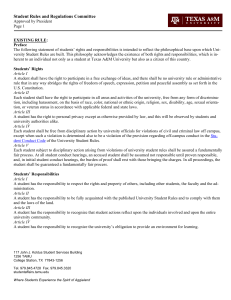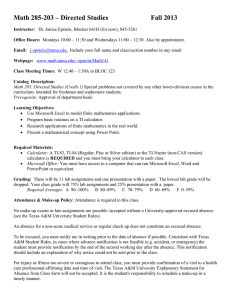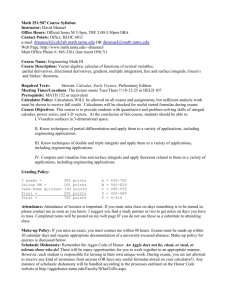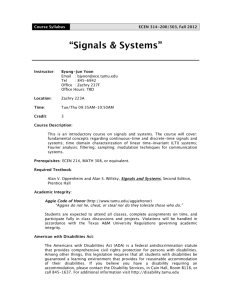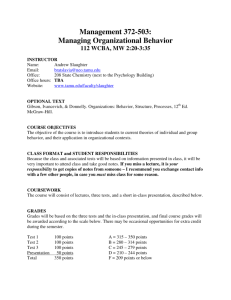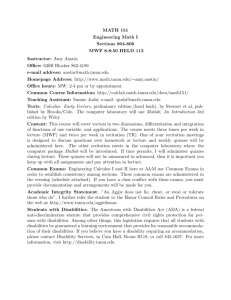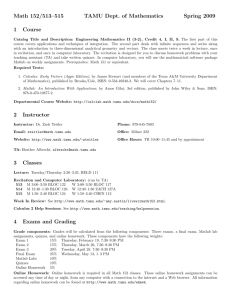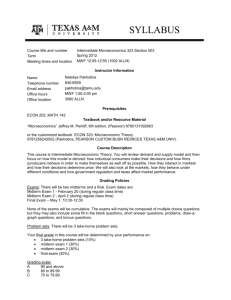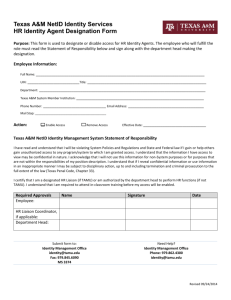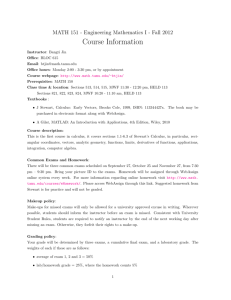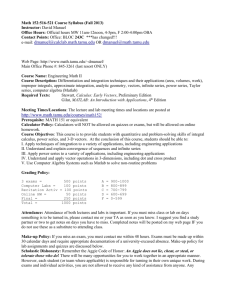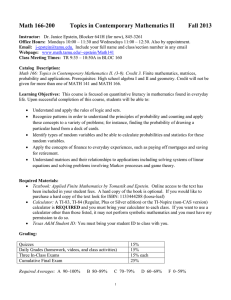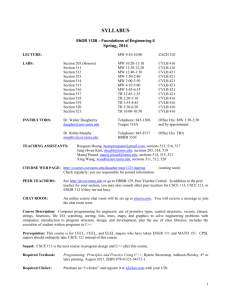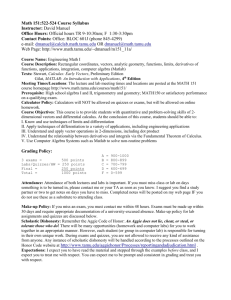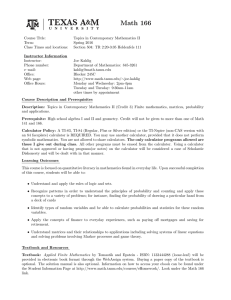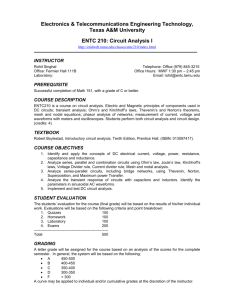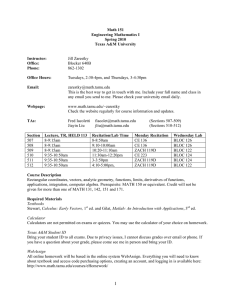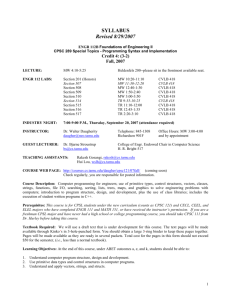COURSE SYLLABUS for ECON 323-501 (TR 3:05
advertisement
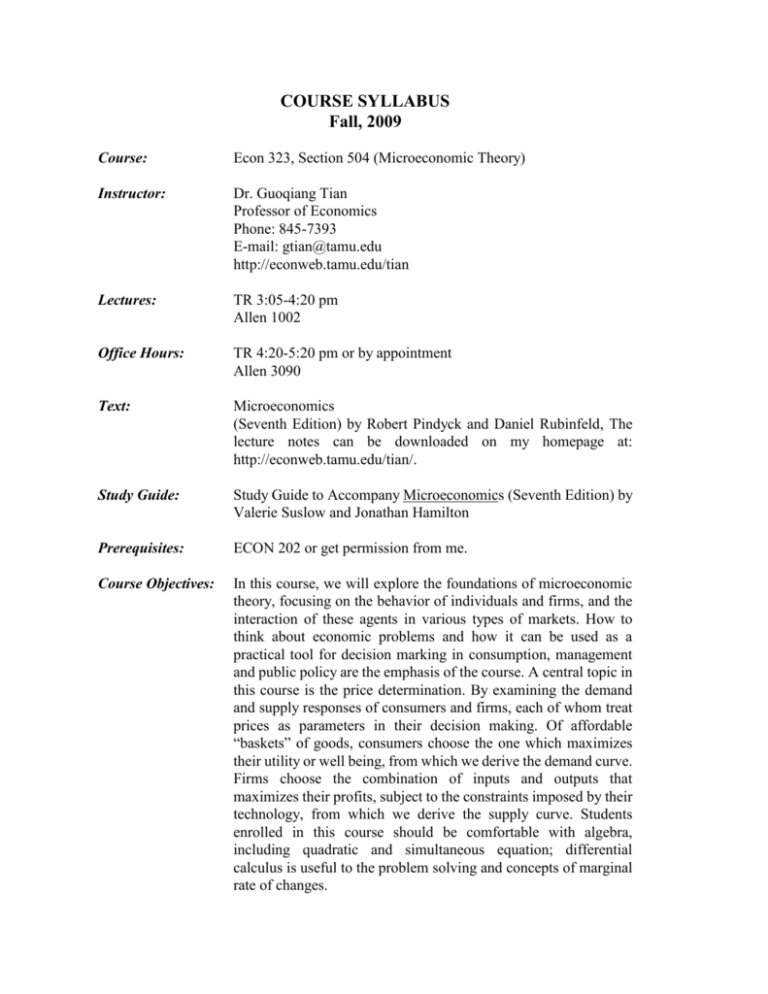
COURSE SYLLABUS Fall, 2009 Course: Econ 323, Section 504 (Microeconomic Theory) Instructor: Dr. Guoqiang Tian Professor of Economics Phone: 845-7393 E-mail: gtian@tamu.edu http://econweb.tamu.edu/tian Lectures: TR 3:05-4:20 pm Allen 1002 Office Hours: TR 4:20-5:20 pm or by appointment Allen 3090 Text: Microeconomics (Seventh Edition) by Robert Pindyck and Daniel Rubinfeld, The lecture notes can be downloaded on my homepage at: http://econweb.tamu.edu/tian/. Study Guide: Study Guide to Accompany Microeconomics (Seventh Edition) by Valerie Suslow and Jonathan Hamilton Prerequisites: ECON 202 or get permission from me. Course Objectives: In this course, we will explore the foundations of microeconomic theory, focusing on the behavior of individuals and firms, and the interaction of these agents in various types of markets. How to think about economic problems and how it can be used as a practical tool for decision marking in consumption, management and public policy are the emphasis of the course. A central topic in this course is the price determination. By examining the demand and supply responses of consumers and firms, each of whom treat prices as parameters in their decision making. Of affordable “baskets” of goods, consumers choose the one which maximizes their utility or well being, from which we derive the demand curve. Firms choose the combination of inputs and outputs that maximizes their profits, subject to the constraints imposed by their technology, from which we derive the supply curve. Students enrolled in this course should be comfortable with algebra, including quadratic and simultaneous equation; differential calculus is useful to the problem solving and concepts of marginal rate of changes. Homework: There will be three homework assignments. The questions in these problem sets can help you understand the Text’s materials and lectures. They also serve as the guidance for you to prepare the exams. You are asked to form study groups yourself to work on these homework assignments. A group should consist of three to four students. Course Grades: Your grade will be mainly based on the performance of three homework assignments and three 75-minute tests. Each of homework assignments and exams is up to 100 points. Your grade will be calculated using the method listed below: Homework: Exam: 20% 80% That is given by the formula: (HW 1 + HW 2 + HW3)x20% + (Test 1 + Test 2 + Test 3)x80% The maximum total points you can earn from homework assignments and tests are thus 300. The grade distribution is as follows. A student with points between 270-300, 240-269, 210-239, 180-209, or 0-179 will receive a grad A, B, C, D, or F, respectively, which may yield approximately 15% A's, 30% B's, 30% C's, 20% D's, and 5% F's. Exam Schedule: I have set up tentative dates of the exams, which may be changed depending on the progress of lectures. Test # 1: Tuesday, September 29, 3:05-4:20 pm Test # 2: Thursday, October 29, 3:05-4:20 pm. Test # 3: Tuesday, December 3, 3:05-4:20 pm Make-Up Policy: Make-up exams are allowed only for a university authorized reason and receiving prior approval from me. Attendance Policy: You are required to attend classes. Attendance will be regularly checked. To implement this policy effectively, 15 bonus points are given to students with perfect attendance. Every two points will be deducted for each missing class without my prior approval till all of 15 bonus points are taken off. Study Habits: Attend classes regularly as required. Students who do not attend classes virtually all the time do not do well. Read the relevant materials in the textbook and lecture notes in advance. If you walk into class with some background, it can help you understand new materials and it not easily get lost. Also, study those lecture presentations extensively on the same day as the lecture. Take most of your time on the materials covered in class. I lecture over the things that I think most important. The textbook is back-up to help you learn, and contains some useful information that I may not have time to cover, or that I think is fairly transparent and that you can get on your own. ADA Policy Statement: The Americans with Disabilities Act (ADA) is a federal anti-discrimination statute that provides comprehensive civil rights protection for persons with disabilities. Among other things, this legislation requires that all students with is abilities be guaranteed a learning environment that provides for reasonable accommodation of their disabilities. If you believe you have a disability requiring an accommodation, please contact Disability Services, in Cain Hall, Room B118, or call 845-1637. For additional information, visit http://disability.tamu.edu. Academic Integrity Statements:“An Aggie does not lie, cheat, or steal or tolerate those who do.” Upon accepting admission to Texas A&M University, a student immediately assumes a commitment to uphold the Honor Code, to accept responsibility for learning, and to follow the philosophy and rules of the Honor System. Students will be required to state their commitment on examinations, research papers, and other academic work. Ignorance of the rules does not exclude any member of the TAMU community from the requirements or the processes of the Honor System. For additional information please visit: www.tamu.edu/aggiehonor/ Tentative Topics Outline: Test 1 Part I. The Demand and Supply Analysis 1. Preliminaries (Chapter 1, pp. 3-19) 2. The Basics of Supply and Demand (Chapter 2, pp. 21-64) Part II. The Theory of Consumer: Consumer Behavior and Demand 3. Consumer Behavior (Chapter 3, pp. 67-100) 4. Individual and Market Demand (Chapter 4, pp. 111-140) Test 2 Part III. The Producer Theory: Production and Competitive Markets 5. 6. 7. 8. Production (Chapter 6, pp. 195-220) The Cost of Production (Chapter 7, pp. 221-251) Profit Maximization and Competitive Supply (Chapter 8, pp. 271-308) The Analysis of Competitive Markets (Chapter 9, pp. 309-335) Test 3 Part IV. Market Structure and Competitive Strategies 9. 10. 11. 12. 13. Market Power: Monopoly and Monopsony (Chapter 10, pp. 349-390) Pricing with Market Power (Chapter 11, pp. 391-406) Monopolistic Competitive and Oligopoly (Chapter 12, pp. 443-478) Game Theory and Competitive Strategy (Chapter 13, pp. 479-497) Markets for Factor Inputs (Chapter 14, pp. 515-542) If time permits, we may cover materials selected from the following chapters. Chapter 5: Uncertainty and Consumer Behavior Chapter 15: Investment, Time, and Capital Markets Chapter 16: General Equilibrium and Economic Efficiency Chapter 17: Markets with Asymmetric Information Chapter 18: Externalities and Public Goods
